Strawberries Are A Great Introduction To Fruit Growing – These Gardeners Share How

FRUIT > STRAWBERRIES

Elizabeth is a Permaculture Garden Designer, Sustainability Consultant and Professional Writer, working as an advocate for positive change. She graduated from the University of St. Andrews with an MA in English and Philosophy and obtained a Diploma in Applied Permaculture Design from the Permaculture Association.
Reviewed By PETER LICKORISH

Peter is a Horticulture Lecturer and self-employed Horticulturist, with a passion for diverse areas of the industry - from garden design to the science behind plant growth and propagation. He has completed the Royal Horticultural Society’s Master of Horticulture (MHort) Award and lectures on RHS courses at Bedford College.
Contributions From HUMAIRA IKRAM

The founder of Studio Ikram, Humaira has worked as a professional Garden Designer for over 10 years. She also runs a Garden Design course at KLC School of Design and is a Garden Adviser to the RHS. Humaira regularly contributes to BBC Gardener’s Question Time and has also featured on flower shows across Netflix and the BBC.
STRAWBERRY GUIDES
Container Growing
Growing From Runners
Hanging Baskets
Hydroponic Growing
Strawberries are a great crop for both beginners and more experienced gardeners and are also one of the best fruits to grow in your garden.
There are a wide range of different strawberries that you can grow.
“I’ve got alpine strawberries growing in my garden, which are so useful because they cover the ground so you don’t get the weeds in, but you also get the harvest,” shares Garden Designer Humaira Ikram.
In this article, we will focus on Fragaria x ananassa, the typical garden strawberry, though it is worth noting that there are other strawberries you could try which like very different growing conditions and can thrive where ordinary garden strawberries will not.
Overview
| Botanical Name | Fragaria x ananassa |
| Common Name(s) | Garden Strawberry |
| Plant Type | Perennial Fruit |
| Native Area | Cultivated |
| Hardiness Rating | H6 |
| Foliage | Deciduous |
| Flowers | White or pink |
| When To Plant | March-May or July-October |
| Harvesting Months | June-September |
| When To Prune | August-September |
Sunlight
Preferred
Full Sun
Exposure
Sheltered
Size
Height
0.1 – 0.5M
Spread
0.5 – 1M
Bloom Time
Late Spring / Early Summer
Soil
Preferred
Loam
Moisture
Moist but well-drained
pH
Neutral
Before we delve a little deeper and help you pick the right strawberries for your garden, it is worthwhile first discussing a little exactly why growing strawberries can be such a great idea.
Strawberries are a great introduction to fruit growing.

They are one of the easiest perennial crops to grow, and are one of the UK’s favourite fruits.
Their sweet, delicious flavour makes them a firm favourite with kids and adults alike.
Strawberry Types
As mentioned above, in this article, we will focus on the most commonly grown strawberries – Fragaria x ananassa.
These garden strawberries are for full sun, while others like F. vesca work well in partial or dappled shade.
Garden strawberries are commonly subdivided into several types depending on when they fruit.

There are early season, mid-season and late season varieties.
There are also a few ever-bearing varieties and a few day-neutral ones.
Early, mid and late season varieties are sometimes also referred to as ‘June bearing’ types.
Their fruiting period is far more condensed, unlike day-neutral and ever-bearing plants.
Though depending on the location and climate, and whether they are early, mid or late season, they can be ready to harvest any time in June or July.
Ever-bearing strawberries (which include some F. x ananassa cultivars) are not truly ever-bearing, but they can offer 2-3 harvests per year between June and August.
Day-neutral varieties are much rarer, but these genuinely can fruit from June right through to late summer in mild-warm conditions.
“I’m often asked what my favourite strawberry is to grow,” shares Master Horticulturist Peter Lickorish.
“Whilst pineberries, white, pineapple-flavoured strawberries, are quirky and fun, I am a big fan of the strawberry cultivar ‘Pegasus’. For me, it balances the desirable traits of disease resistance, size, sweetness and good cropping.
“It is a late June-bearing variety crowned with the RHS Award of Garden Merit.”
Planting
Where To Grow
Strawberries can be grown in even the smallest of spaces, so if you have a tiny garden or just a sunny windowsill, you will still be able to give it a go.
They can be grown in their own dedicated beds, in mixed perennial beds or borders, as path or bed edging, or in containers, no matter how much space is available.
Garden strawberries need a sunny, sheltered site, with moist yet free-draining, reasonably fertile soil.
A good quality loam soil enriched with plenty of organic matter is ideal.
If growing in containers of some kind, these should be filled with a growing medium which can retain moisture while also draining moderately freely.
If you have decided to plant strawberries in the ground, then the first decision you will have to make after cultivar selection is whether you will grow from seed, from runners, or from bare root or pot-grown plants.
Growing From Seed
Growing from seed is possible, but it is certainly not the easiest option to choose.
Growing from seed is usually only an option taken for certain ever-bearing garden strawberry cultivars (and other strawberry types like alpine strawberries or wild strawberries which do not send out runners).

The seeds are often refrigerated in damp material such as vermiculite for a few weeks immediately prior to sowing to improve germination rates, and the young strawberry plants need a lot of initial care and will not fruit in their first year.
Hybrid varieties will not come true from seed, so our advice is to simply purchase some strawberry runners or young strawberry plants to start growing them at home.
Growing From Bare Root
Runners or the young plants which come from them can also be ordered or purchased and planted out as bare root plants in September-October, or in April.
Pot grown strawberry plants can also be purchased and planted out between April and June.
Plant Care
Strawberries are easy to grow and care for, but it is important to make sure that you have the basics in place.
Here are some key things to bear in mind when it comes to strawberry care and growing:
Preferred Soil
Remember that strawberries prefer moist yet free-draining soil.
They do best in soil which is reasonably fertile too so it can meet their nutritional needs.
Make sure that you mulch well around your strawberries to retain moisture, add fertility and, during the fruiting period, keep fruits up and off the soil so they do not rot.
The mulch used around the fruiting period should be relatively dry and their namesake straw is a good option.
Watering & Feeding
It is important to think about water needs when deciding where to grow your strawberries.
You need to be able to water strawberry plants well throughout the growing season, especially during dry spells, when the strawberries are young, and when they are being grown in containers.
Make sure you water strawberries from below or ensure that water hits the soil where it is needed and not the foliage or the crowns of the plants or fruits.
It is a good idea, for the best yields, to feed strawberry plants regularly from spring onwards with an organic liquid feed which is high in potassium to encourage good fruit formation.
A comfrey tea is one great option to consider.
Fertility can also be ensured by mulching around the plants and by considering options for companion planting which can help keep strawberries happy and healthy.
Weeding
When planted relatively closely in the ground (around 40cm or so apart), strawberries should create a good ground cover, which can reduce the incidence of weeds.
However, especially while the strawberries are still young, you should weed a little to make sure there is no excessive competition and the strawberry planting area does not become congested or overcrowded.
Remember, spacing requirements can vary significantly depending on the growth habits, root systems and nutritional and water requirements of neighbouring plants.
Certain companion plants can be planted close to strawberries without having a detrimental effect on growth or yields.
Common Problems
If you take care of strawberries’ basic environmental needs as discussed above and make sure there is plenty of biodiversity in your garden, you should not have excessive problems with pests or diseases.
However, strawberries can be plagued by a number of pests, particularly slugs and snails, birds, and rodents – which all may eat the berries before you get the chance to.
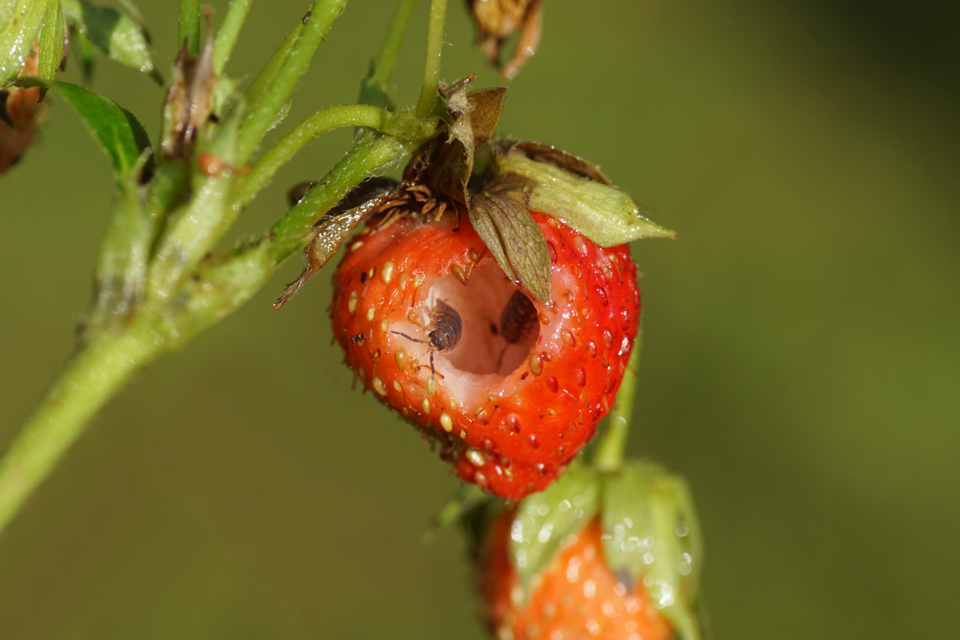
Encouraging plenty of natural predation in your garden can help keep pest numbers down but protecting your crop with straw and netting where necessary can also be a good idea.
Avoiding wetting the foliage and fruits and keeping strawberries up off the soil with a mulch of straw or similar should help you avoid common fungal diseases such as grey mould or Verticillium wilt.
Harvesting
Strawberries are ready to harvest, typically, when they are bright red all over.
Ideally, you should check over your plants regularly to make sure you harvest at the optimal time.
If possible, you should aim to harvest your strawberries on a sunny day, during the warmest part of the day when the fruits will be at their sweetest.
Strawberries will not keep very long at all when fresh, so you may wish to consider freezing your harvest or preserving it in another way if you won’t be eating the fruit within a few days.
Picking fruit with the calyx and around 1cm of stem intact helps preserve the fruit a little, but it should be removed before freezing or preserving the berries.
Rotating
One important thing to remember about strawberries is that while they are perennials, which will fruit over a number of years, productivity and yield will begin to drop off after a few years.
Plants which are more than three years old will not bear as much fruit.
Strawberry plants are generally most productive in their second and third years, after which fruit production will gradually drop off.
Accumulation of plant viruses is one reason why fruiting declines and there may be no other signs of these viruses.
For this reason, it is a good idea when growing strawberries to rotate out older plants after three years and plant a new bed of strawberries elsewhere.
